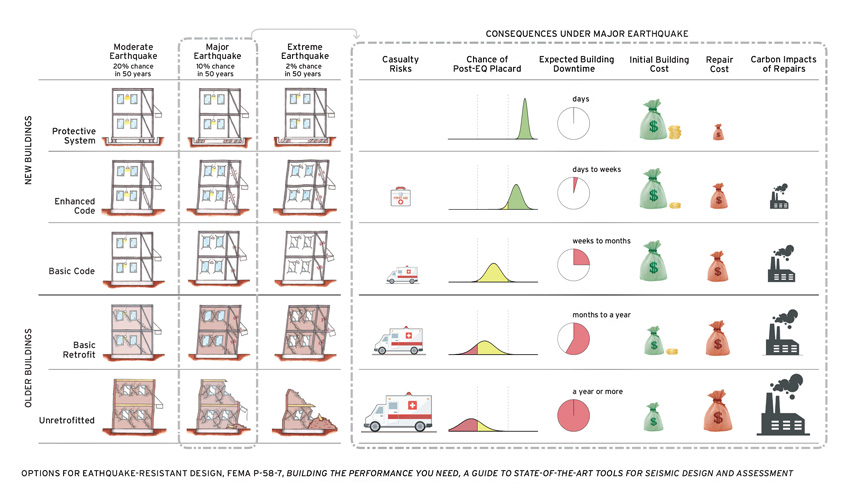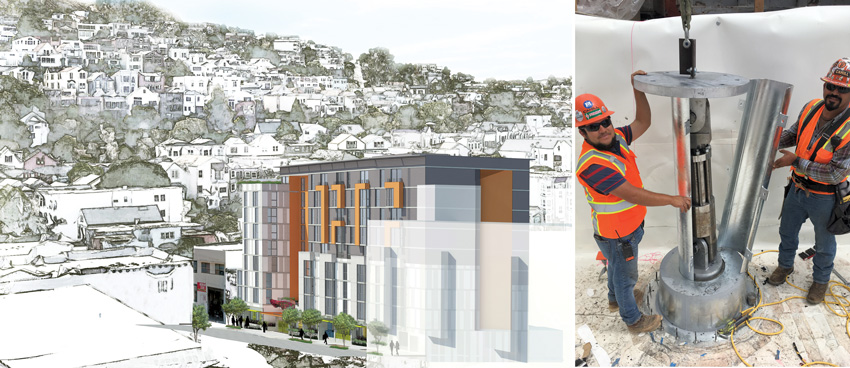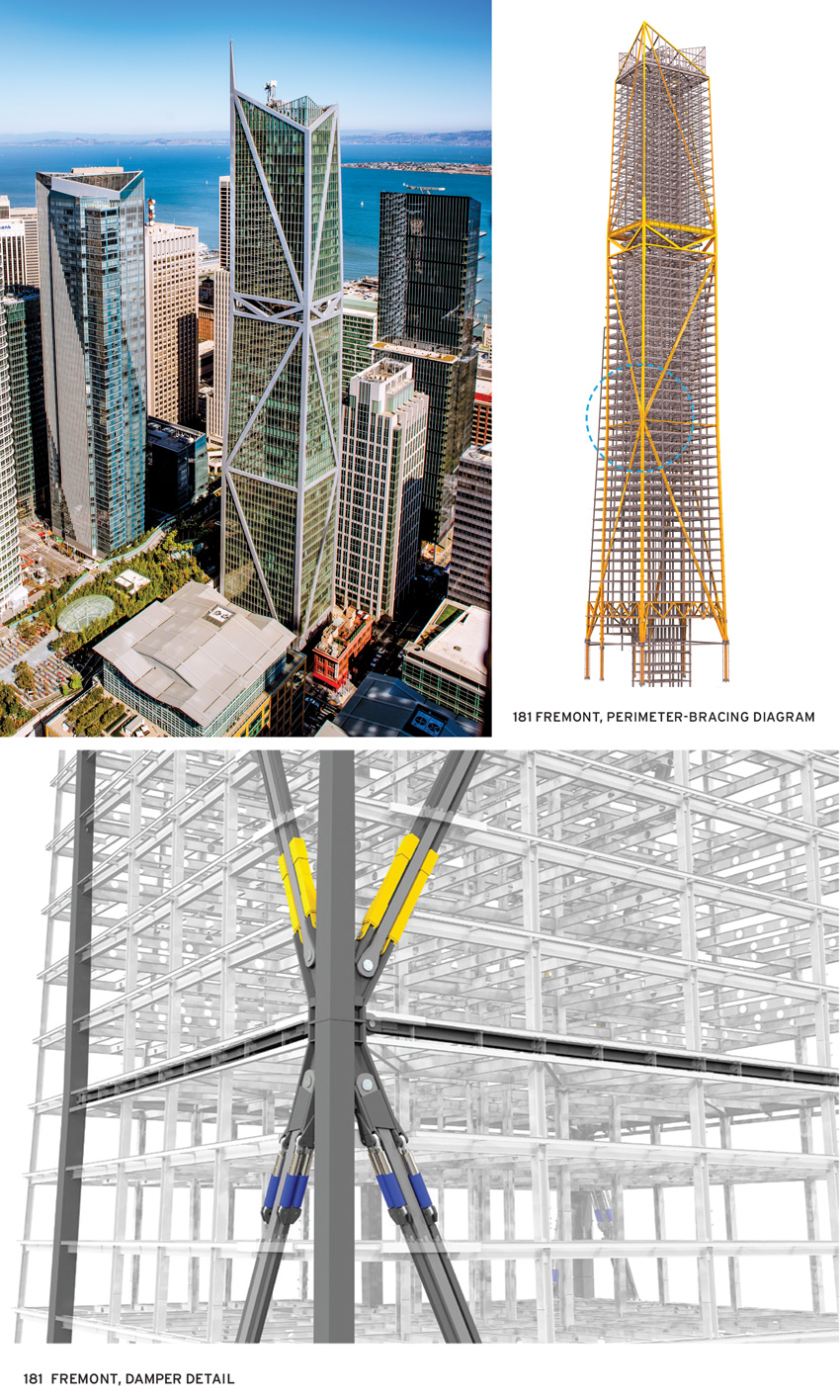This CE Center article is no longer eligible for receiving credits.
View course on architecturalrecord.com
Resilience is the ability to bounce back after a disturbance or interruption, or the capacity to withstand, recover from, or adapt to stress, misfortune, or change. By now, design teams are at least accustomed to considering this concept and a building’s response to such hazards as flooding, intense wind, and drought. You might assume that for one threat in particular—earthquakes—modern codes assure resilience, essentially guaranteeing that recently built structures can be quickly reoccupied, or at least readily repaired. It sounds totally reasonable—right? But that is not the case. Codes were devised to protect lives, not property, so they do little to limit the kind of destruction that might make a building uninhabitable for an extended period of time or even necessitate demolition. In fact, recent studies often quoted in engineering circles estimate that code-compliant buildings could suffer two years of downtime after a significant quake. “By design, codes focus only on safety, and therefore tolerate lots of damage,” says David Mar, partner at Berkeley, California-based Mar Structural Design.

IMAGES: © ADAM MØRK (TOP, AND BOTTOM, RIGHT); COURTESY SCHMIDT HAMMER LASSEN (BOTTOM, LEFT)
The new central library (top) in Christchurch, New Zealand, is one of several anchor projects in the redevelopment of the city’s downtown (bottom right) following a string of earthquakes in 2010 and 2011. Much of its five-story rectangular volume is surrounded by a perforated golden veil, omitted in places to reveal terraces and allow views to the surrounding landscape.
But while engineers are still prioritizing human safety, they are also working to raise the bar, thanks to better simulation tools and the maturation, over the past two or three decades, of performance-based design, an alternative to the prescriptive, code-based approach. “As a general notion, performance-based design can allow project teams to choose a performance level for any event or hazard, with resilience as the most ambitious goal,” says Jon Heintz, the executive director of the Applied Technology Council (ATC), a nonprofit that promotes engineering research.
This focus on enhanced performance is a global trend. Seismic resilience might not be necessary for all buildings, but it is certainly relevant for those that represent a significant investment, house critical business activities, provide essential services, or are important community or cultural assets. One such recent project is Turanga, the new central library in Christchurch, New Zealand, which opened last year and included stringent structural and seismic criteria as part of its bidding requirements. Its performance goals are not surprising: the $63 million, 106,000-square-foot library, designed by the New Zealand-based firm Architectus with Danish architects Schmidt Hammer Lassen, is considered one of several anchor projects vital to the redevelopment of Christchurch after a series of major temblors hit the region in 2010 and 2011. Ultimately, 70 percent of the city’s downtown was demolished due to extensive damage, though very few buildings had actually collapsed.
Local engineering firm Lewis Bradford Consulting Engineers developed what they term a “low-damage” seismic solution for Turanga. In addition to safeguarding the occupants, the strategy is intended to protect the structure, the fabric of the building, and its contents. A folded, perforated metal veil surrounds much of the library’s five-story rectangular volume, but is selectively omitted in some sections to reveal terraces and allow views to the surrounding landscape. Underneath this skin, at the building’s perimeter, is a largely conventional steel moment-resisting frame providing approximately 30 percent of the structure’s earthquake-load resistance. Most of the seismic work, however, will be done by three “rocking wall” cores that allow the building to sway and then return to its original position.
These vertical cores consist of 82-foot-tall post-tensioned, site-cast concrete walls with high force-to-volume extrusion dampers linking the walls’ bases to the foundation and U-shaped flexural plates (UFP) that connect the core walls to corner columns. The UFP energy-dissipation devices are considered sacrificial, since they could be damaged in a very large quake—one with a 1,000-year return period. However, all of the damage should be confined to these elements, which have bolted connections, enabling their replacement, explains Tim Shannon, Lewis Bradford’s technical director.

IMAGES: COURTESY LEWIS BRADFORD CONSULTING ENGINEERS
The Christchurch library’s structural system comprises a largely conventional steel moment frame and three “rocking wall” cores (right). The cores (top, right), which recenter the building after a quake, include 82-foot-tall post-tensioned, site-cast concrete walls (left).
View course on architecturalrecord.com
Resilience is the ability to bounce back after a disturbance or interruption, or the capacity to withstand, recover from, or adapt to stress, misfortune, or change. By now, design teams are at least accustomed to considering this concept and a building’s response to such hazards as flooding, intense wind, and drought. You might assume that for one threat in particular—earthquakes—modern codes assure resilience, essentially guaranteeing that recently built structures can be quickly reoccupied, or at least readily repaired. It sounds totally reasonable—right? But that is not the case. Codes were devised to protect lives, not property, so they do little to limit the kind of destruction that might make a building uninhabitable for an extended period of time or even necessitate demolition. In fact, recent studies often quoted in engineering circles estimate that code-compliant buildings could suffer two years of downtime after a significant quake. “By design, codes focus only on safety, and therefore tolerate lots of damage,” says David Mar, partner at Berkeley, California-based Mar Structural Design.

IMAGES: © ADAM MØRK (TOP, AND BOTTOM, RIGHT); COURTESY SCHMIDT HAMMER LASSEN (BOTTOM, LEFT)
The new central library (top) in Christchurch, New Zealand, is one of several anchor projects in the redevelopment of the city’s downtown (bottom right) following a string of earthquakes in 2010 and 2011. Much of its five-story rectangular volume is surrounded by a perforated golden veil, omitted in places to reveal terraces and allow views to the surrounding landscape.
But while engineers are still prioritizing human safety, they are also working to raise the bar, thanks to better simulation tools and the maturation, over the past two or three decades, of performance-based design, an alternative to the prescriptive, code-based approach. “As a general notion, performance-based design can allow project teams to choose a performance level for any event or hazard, with resilience as the most ambitious goal,” says Jon Heintz, the executive director of the Applied Technology Council (ATC), a nonprofit that promotes engineering research.
This focus on enhanced performance is a global trend. Seismic resilience might not be necessary for all buildings, but it is certainly relevant for those that represent a significant investment, house critical business activities, provide essential services, or are important community or cultural assets. One such recent project is Turanga, the new central library in Christchurch, New Zealand, which opened last year and included stringent structural and seismic criteria as part of its bidding requirements. Its performance goals are not surprising: the $63 million, 106,000-square-foot library, designed by the New Zealand-based firm Architectus with Danish architects Schmidt Hammer Lassen, is considered one of several anchor projects vital to the redevelopment of Christchurch after a series of major temblors hit the region in 2010 and 2011. Ultimately, 70 percent of the city’s downtown was demolished due to extensive damage, though very few buildings had actually collapsed.
Local engineering firm Lewis Bradford Consulting Engineers developed what they term a “low-damage” seismic solution for Turanga. In addition to safeguarding the occupants, the strategy is intended to protect the structure, the fabric of the building, and its contents. A folded, perforated metal veil surrounds much of the library’s five-story rectangular volume, but is selectively omitted in some sections to reveal terraces and allow views to the surrounding landscape. Underneath this skin, at the building’s perimeter, is a largely conventional steel moment-resisting frame providing approximately 30 percent of the structure’s earthquake-load resistance. Most of the seismic work, however, will be done by three “rocking wall” cores that allow the building to sway and then return to its original position.
These vertical cores consist of 82-foot-tall post-tensioned, site-cast concrete walls with high force-to-volume extrusion dampers linking the walls’ bases to the foundation and U-shaped flexural plates (UFP) that connect the core walls to corner columns. The UFP energy-dissipation devices are considered sacrificial, since they could be damaged in a very large quake—one with a 1,000-year return period. However, all of the damage should be confined to these elements, which have bolted connections, enabling their replacement, explains Tim Shannon, Lewis Bradford’s technical director.

IMAGES: COURTESY LEWIS BRADFORD CONSULTING ENGINEERS
The Christchurch library’s structural system comprises a largely conventional steel moment frame and three “rocking wall” cores (right). The cores (top, right), which recenter the building after a quake, include 82-foot-tall post-tensioned, site-cast concrete walls (left).
In addition to enhanced seismic performance, the scheme was desirable from an architectural standpoint, says Morten Schmidt, Schmidt Hammer Lassen cofounder. The strategy limited the need for lateral braces, allowing the architects to create flexible floor plates and open the center of the building to a skylit atrium. “Braces would have been a barrier and constraint, but we managed to get rid of them,” he says.
In recent years, tools and standards have emerged to assist engineers in understanding the trade-offs and risks implicit in seismic-design decisions. One example is FEMA P-58, a performance-based analysis methodology developed by the ATC and funded by the Federal Emergency Management Agency. It provides quantitative descriptions of damage for both existing and new buildings, considering structural components as well as nonstructural elements, including facades, finishes, and mechanical systems. It helps project teams estimate the repair costs and the amount of time a building might be uninhabitable as a consequence of design choices. It even can help determine the amount of greenhouse gases that would be generated as the result of necessary repairs. The aim is to “couple structural behavior with losses,” says Mar, who is one of many engineers who has served as a consultant on the P-58 effort. First released in 2012, a P-58 update will be published in the first quarter of this year. It will include a new set of design guidelines and, for the first time, a section targeting clients, developers, and other non-engineering decision-makers.
Along with evaluation tools like P-58, LEED-like frameworks to rank building performance in the face of seismic threats have also been emerging, including one created by the nonprofit U.S. Resiliency Council (USRC), and another developed by the engineering firm Arup, known as the Resilience-based Earthquake Design Initiative (REDi). While both the USRC and Arup are working to expand their respective programs to encompass other hazards, such as flooding and high winds, the current versions of both systems are still focused on seismic design and are intended to help teams achieve beyond-code performance. While Arup’s REDi targets high-profile new-construction projects, the USRC’s system is geared for a range of existing as well as new structures. To date, the nonprofit’s certified projects include the seismic retrofit of a nondescript retail building in San Gabriel, California, and an elaborate, recently dedicated Mormon temple in Concepción, Chile. “The program is aimed at a broad swath of owners,” says Evan Reis, the organization’s executive director.

IMAGE: © FEMA
The analysis tool FEMA P-58 can be used by project teams to understand the trade-offs and risks implicit in seismic-design decisions for both new and existing buildings. It can help them develop quantitative descriptions of initial invest-ment, potential damage, repair costs, and downtime.
One project seeking USRC certification is Casa Adelante, now under construction in San Francisco’s Mission District. When complete late this year, it will provide 93 apartments for low-income seniors in a neighborhood that the building’s architect, Susie Coliver, principal of Herman Coliver Locus, describes as “ground zero for gentrification.” The approximately $40 million nine-story project is aiming for USRC Gold (the second-highest level of certification), which means that, in addition to protecting occupants against major injury, Casa Adelante should sustain damage amounting to less than 10 percent of its replacement cost, with minimal disruption to operations. The building includes 19 units for the formerly homeless, making its enhanced performance goal particularly appropriate, points out Coliver. “After a quake, there would be few options for affordable housing for these seniors,” she says. “There is so little of it anyway.”

IMAGES: COURTESY HERMAN COLIVER LOCUS
Casa Adelante (left), under construction in San Francisco’s Mission District, will provide 93 apartments for low-income seniors. It is aiming for USRC Gold certification, with a seismic system that includes dampers (right) developed for the project in New Zealand.
The project’s seismic resilience has been accomplished primarily with elements found in many Bay Area multiunit residential buildings, including reinforced-concrete floor plates, columns, and shear walls. But at Casa Adelante, these largely conventional components have been tuned through sophisticated computer simulations. “Their dynamics have been considered all together, as a system,
to make some parts stronger and others weaker,” explains Mar, the project’s structural engineer. The idea is that the building will realign itself after an earthquake’s shaking, behaving in a manner similar to the new library in Christchurch.
The only somewhat exotic components at Casa Adelante are a set of four dampers specially manufactured in New Zealand and designed with the help of Geoffrey Rodgers, an engineer and professor at the University of Canterbury in Christchurch, who also had a hand in Turanga. The dampers, necessary because the shear walls are located close to the building’s exterior, sit between a mat slab and the foundation’s piers, permitting the slab to lift but then be pulled back. Because Rodgers donated his time and convinced other collaborators involved in creating the devices to do the same, the project’s nonprofit developers are paying only $4,000 for each damper. This marginal cost would have been considerably higher had all the fees normally associated with design and fabrication been included.
Keeping added expenses low while improving performance is one of the main aims of the larger seismic-resilience endeavor. “Our mission is to substantially reduce risk with very little premium—between 0 and 5 percent,” says Ibrahim Almufti, an associate principal in the San Francisco office of Arup and one of the primary authors of REDi. He says that many clients are unaware of the potential consequences of meeting only the prescriptive requirements of the building code, citing his firm’s experience as structural and geotechnical engineer at 181 Fremont, a 56-story office and condominium tower designed by Heller Manus and completed last year, directly adjacent to San Francisco’s Salesforce Transit Center. The building’s owners were surprised to learn that if typical seismic-performance objectives were pursued the tower might be unusable for two years after a major quake. They therefore opted for a beyond-code approach, targeting REDi Gold, the program’s second-highest level of certification, which includes immediate reoccupancy after a 475-year earthquake, with limited disruption to functionality.
The tower’s seismic strategy comprises a dual system of a perimeter moment frame and composite megacolumns and a steel megabrace, all rising from a foundation that includes piles socketed into bedrock, more than 200 feet below the street. Earthquake-resistance is dependent almost entirely on these perimeter elements, since the slenderness of 181 Fremont—with a base that is only 120 by 90 feet—did not permit a structural core in the office portion, which occupies the lower 37 floors. But above, in the residential levels, there is a secondary system, with a core reinforced with buckling restrained braces. The tower is designed to uplift slightly, about an inch, in a large quake—one known as a maximum considered earthquake, or MCE, defined by code as a seismic event that has a 2 percent chance of occurring in 50 years. Each megacolumn includes a shear key, which was devised to allow forces to be transmitted to the foundation without the tower moving side to side, explains Almufti.

IMAGES: © STEVE PROEHL (TOP, LEFT); COURTESY ARUP (TOP, RIGHT AND BOTTOM)
San Francisco’s 181 Fremont, which sits adjacent to the currently closed Salesforce Transit Center and its rooftop garden (top, left), has composite megacolumns and a steel megabrace (top, right) to help it perform in an earthquake. Dampers are integrated into the megabrace (bottom).
At the very top of the building, engineers were able to omit a tuned mass damper (TMD) that had been included in an earlier scheme. Such devices are often incorporated into the crown of slender towers to reduce the sway and acceleration caused by wind, which can make occupants uncomfortable. But at 181 Fremont, Arup instead used viscous dampers, incorporating them into the perimeter mega braces. This approach freed up valuable real estate, allowing for an additional residential penthouse, while also benefiting seismic performance, since the devices mitigate both wind and earthquake forces. The approach also allowed engineers to reduce the structure’s weight and stiffness, which in turn further reduced seismic loading, explains Almufti. The damper system “allowed us to decrease the size of the steel sections, as well as the overall seismic demand,” he says.
As part of their work on 181 Fremont, the engineers also considered nonstructural elements, since repairing or replacing such components can be costly and delay reoccupancy. For instance, a full-scale, three-story facade mockup was used to confirm air- and watertightness after the shaking of a 475-year quake.
The tower’s sophisticated engineering solutions, and those employed at Casa Adelante and Turanga, should help the structures and their occupants quickly recover from a major earthquake. If such beyond-code projects become commonplace, more owners can expect buildings that not only safeguard human life but are genuinely resilient.
 IMAGES: © ADAM MØRK (TOP, AND BOTTOM, RIGHT); COURTESY SCHMIDT HAMMER LASSEN (BOTTOM, LEFT)
IMAGES: © ADAM MØRK (TOP, AND BOTTOM, RIGHT); COURTESY SCHMIDT HAMMER LASSEN (BOTTOM, LEFT)

















